Text
SA SAMAR
May 4-8, 2018 - ”Nasaan na raw po ‘yung mga paintings ni daddy?” (Where are my daddy’s paintings?)
The lack of Waray words in the sentence might’ve encouraged my grandmothers to ignore my inquiry once again. Still, I insist—I cannot let down my dad’s excitement and mine, too. It was my first time in Samar, and right after setting my foot in the tiny Tacloban airport, I knew it was going to be a special experience. It must have been different for them, though. I am just their (literally) distant granddaughter who visited the province for the first time as a representative of my dad, the young man who left his hometown in his 20s and hasn’t come back since.
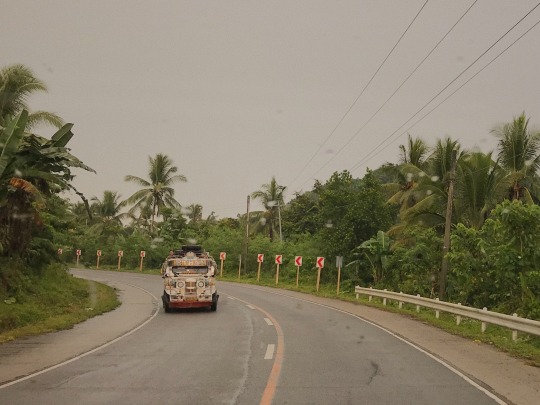
Western Samar, 2018
I traveled to Samar for a 5-day vacation with my two Waray Balikbayan aunties. What they spoke of 60% of the time, I have no clue! Upon landing at Tacloban, we immediately embarked on a 5-hour drive from the airport to my grandmother’s humble home. I’m all groggy and tired, but I can’t waste those 5 hours of stories and beautiful scenery by sleeping.
My aunts hired a local driver and they exchanged short anecdotes on the life of Yolanda survivors after the great Typhoon, the freshness of seafood and vegetables in Samar, the perfect places to buy pasalubongs, etc. I struggle to keep myself in the conversation, asking them to translate in Tagalog a sentence or two.

San Juanico Bridge, 2018
The ride started from souvenir shops, gasoline stations, and small parks, to tall palm trees, an overlooking of the shore, and of course, the Samar-Leyte connection—San Juanico Bridge—and its good-looking view. Serene and beautiful. Not until we noticed the recurring view of identical half-made houses that seemed to be under construction AND abandoned. They were the pabahay (housing) for the victims of Typhoon Yolanda.
Our local driver narrated the current situation of the pabahays. It is a worry that most of the houses can comfortably accommodate only at most 3 people. But, it is even more problematic that most of them currently accommodate less than they can—none—because they are not even halfway done. See, Typhoon Yolanda happened almost 5 years ago.
On a positive note, it is a relief to know that there are housings of good quality provided mostly by the NGOs and other donors. They are medium-sized, beautifully-painted, and some are even equipped with a satellite dish. :)
SAN PEDRO
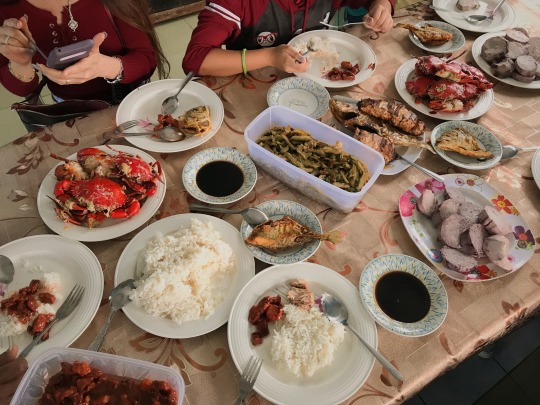
San Pedro, Quinapondan, Eastern Samar, 2018
My grandmother and Aunt Baby, the sweetest of them all, welcomed us with a big hug and a feast of seafood, vegetables, root crops, and meat. Freshness beyond words. We ate together with our hands, and called to meal whosoever happens to pass by the dining area. It was a feast! I can still remember how my hungry, jet-lagged self devoured that meal. Jollibee is no match. Sobrang sarap talaga huhu
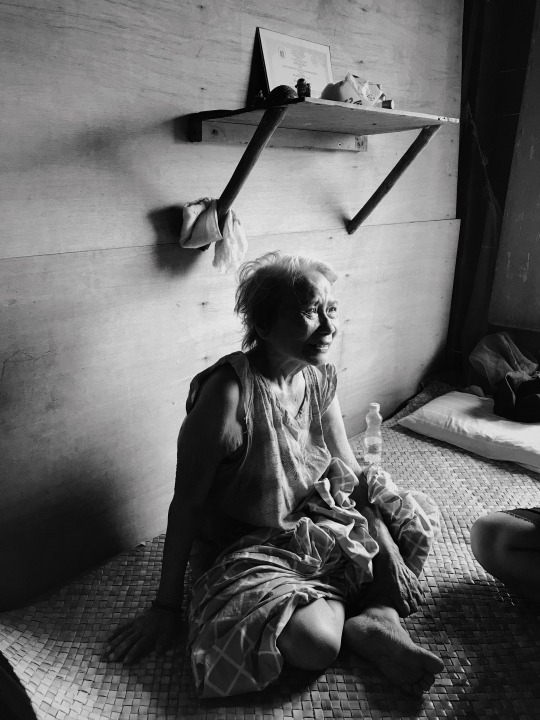
San Pedro, Quinapondan, Eastern Samar, 2018
A mini "welcome tour" from my Aunt Baby followed afterward. Meeting my cousins that day was like meeting them for the first time. We were kids when we last spent time together. My cousins smiled shyly and said nothing as my Aunt Baby called them from their rooms. If their eldest sister--who was of my age--was there, it might have been different.
My Aunt Baby's eldest son tagged along as she led me to the shabby stairs of a bahay kubo across my grandmother's house. The bahay kubo was old and fully furnished, but spacious. It housed relatives I've never met until then: my father’s cousins, their children, and their blind mother—one of my grandmothers. All narrated childhood stories of them and my dad’s. Happy stories, until they get to the part where my daddy left.
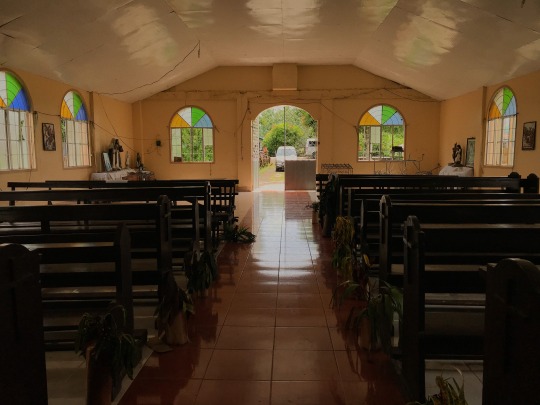
San Pedro Church, Quinapondan, Eastern Samar, 2018

San Pedro Church, Quinapondan, Eastern Samar, 2018 | Fujicolor C200 in Canon TLb
From afar, San Pedro Church looked like a typical province church. Beautiful and small. Up close, it was of dried flowers, broken pews, shattered glass panes, and severed holy statues. I wonder how a church, that stands in the middle of a Barangay, filled with (probably) very religious people, can look so neglected. We said our prayers, and left.
CALICOAN ISLAND

Calicoan Island, Guiuan, Eastern Samar, 2018 | Fujicolor C200 in Canon TLb
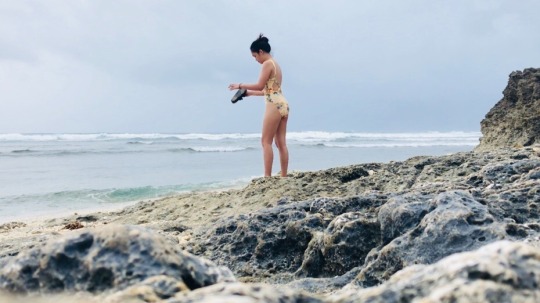
Calicoan Island, Guiuan, Eastern Samar, 2018

Calicoan Island, Guiuan, Eastern Samar, 2018
The moment we arrived, it was low tide. Nevertheless, the Island was beautiful. For someone as easily fascinated as myself, I am in awe. (as usual) I don't have much to say about Calicoan, except that it makes me feel like leaving the City life for good.
Traveling with people who are from a different generation means I have to do my millennial shit alone. And so, that day, as my elders are chitchatting and trying to avoid the sun and the sea, I put on my bathing suit, went down the beach, set up my phone camera beneath the rocks, and took videos and photos of myself along the shore.
Sounds lonely, but it was refreshing.
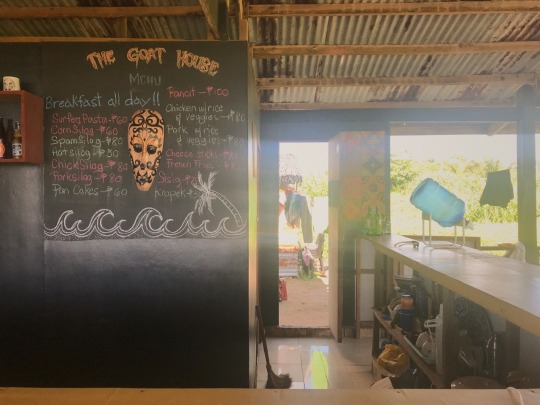
The Goat House, Calicoan Island, Guiuan, Eastern Samar, 2018
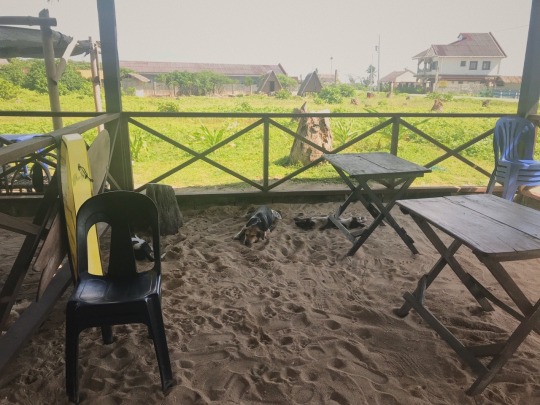
The Goat House, Calicoan Island, Guiuan, Eastern Samar, 2018

The Goat House, Calicoan Island, Guiuan, Eastern Samar, 2018
A few steps away from Calicoan Resort is a surfing spot called ABCD Beach, and across that beach is a small eating place for surfers called The Goat House. I urged my Aunt to try their food, which I had high hopes for. Not as good as I hoped, but the stories we heard inside The Goat House made up for it.
The eatery was manned by 2 locals and a French traveler, the girlfriend of one of the locals. The 32-year-old French waitress served our food, along with the story of the surfing scar on her leg--upon asking. Her travel story followed right after. She was really brave.
Another foreign traveler sits by the wooden bar. The Dutch surfer/customer enthusiastically answered my Aunt's inquiry: "So how's the Philippines?" with very lovely, positive words. It’s a shame that they might’ve experienced the Philippines more than I do. Before leaving, we finished a kakanin that one of my uncles ordered from a vendor by the road. Despite the food, I have no regrets about visiting the place.
SULANGAN
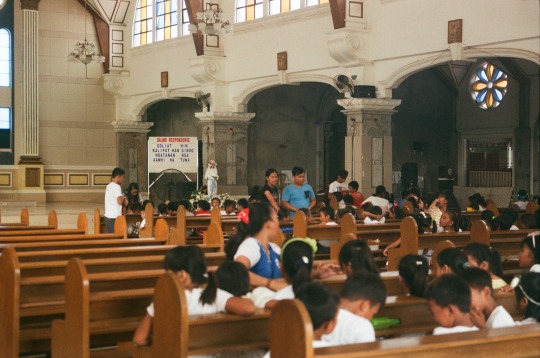
St. Anthony of Padua Parish, Sulangan, Guiuan, Eastern Samar, 2018 | Fujicolor C200 in Canon TLb

St. Anthony of Padua Parish, Sulangan, Guiuan, Eastern Samar, 2018 | Fujicolor C200 in Canon TLb
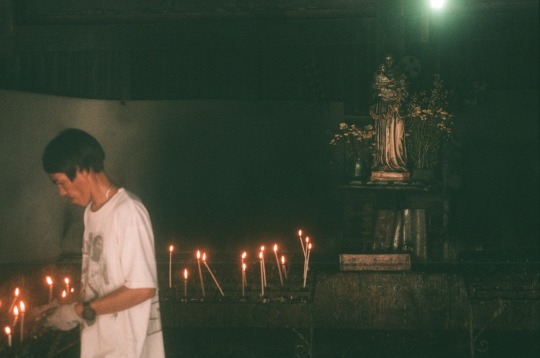
St. Anthony of Padua Parish, Sulangan, Guiuan, Eastern Samar, 2018 | Fujicolor C200 in Canon TLb
This is a corner dedicated for offering prayers to St. Anthony of Padua. As expected, it was filled with Catholic tourists lighting their candles. I waited long for the area to clear up to get a shot. However, as I finally take the long-awaited shot, a man in short bobs and worn-out gloves replaced the group of praying people. He was patiently clearing out the candle drops and leftover wax before another set light new ones. I gladly included him in the frame. Only to find out weeks later that my shot was out of focus. Even so, I enjoyed the people-watching.
SAN PEDRO, AGAIN

San Pedro, Quinapondan, Eastern Samar, 2018
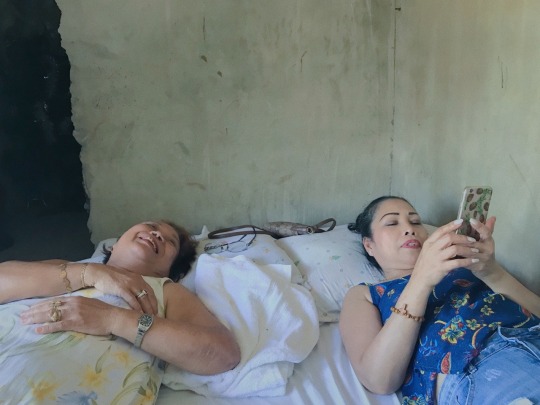
San Pedro, Quinapondan, Eastern Samar, 2018

San Pedro, Quinapondan, Eastern Samar, 2018
It was a mini recap of my dad’s childhood, before finally leaving Samar. I saw the house and the woman--his aunt--who raised my dad. They told me lots of stories, and were very warm. I love old stories by old people.
While my dad was on video call, I looked around the house for the paintings that he was bragging about ever since I landed. This has to be the highlight of my trip--nothing’s more interesting, so far, than my father’s long lost art! Finding nothing, I inquired once again:
“Nasaan na raw po ‘yung mga paintings ni daddy?”
(Where are my daddy’s paintings?)
I got my answer.
“Wala na, natangay ng Yolanda.”
(None are left, they are taken away by (Typhoon) Yolanda.)
For a while there, I was devastated. I could sense my dad was too. So, I let him talk to his old friends and family. He was laughing the whole time, despite the weak signal, pixelated faces, and slurry words.
At that moment, I decided I should go back soon. I’ll be with dad. He will be coming home, too.
--‘Till next time!
3 notes
·
View notes
Text
SHOOTING IN FILM, A FIRST

Hidalgo St., Quiapo, Manila, 2018
Geoffel at the camera shop. This is my first shot using film.
May 1, 2018 - I’ve never had a heart for photography—even though I’ve been to photography workshops and opportunities (Thanks to my undergrad org!) No workshop, back then, would have ever made me understand aperture, ISO, and shutter speed wholeheartedly. My intention to learn how to shoot in film, therefore, had never been about a burning love for photography. It was more of a quencher to my curiosity of old stuff and of special things that are often forgotten nowadays, and a distraction to the realities of adulting. The process of it all is what I’m after. Although, I do try my best to produce good photos, too.
For my very first film camera, I bought a Canon TLb (and loaded it with Fujicolor C200) at Hidalgo Street, Quiapo, Manila. It’s second-hand, very old, and so, very cheap—which works for me because I like old and CHEAP stuff. The quality of the output is compromised, though. The whole selection process was really simple, especially because I HAVE NO IDEA. I simply laid out my current status: “A noobie who wants to learn how to use a very manual film camera at a very low price,” and bought (after hours of pondering) the first camera handed out to me. Trust issues aside, it was an easy decision to make. Shout-out to Tito Fernan, the man who sold the camera, for giving me a head-start on film photography. Heart heart.
Side note: That Quiapo trip is one of my favourite parts of all this crazy, and it’s also my first time. Quiapo was old and raw. I saw the people in all those Quiapo stories come to life—the fortune tellers, the sketchy herbal medicines vendors, the old uncles manning their cheap camera shops, etc. Thank god I didn’t encounter the snatchers—with which it’s also known for. For Quiapo, I have nothing but wide eyes.
The film photography experience is overwhelming, but satisfying. Roaming the streets with an old camera of around 1 kg size, remembering to cock the shutter (in a correct way—I fucked up a lot D:) before every shot, and focusing on the subject through dusty old lens was no joke for this beginner. I even exposed some of my frames because I thought I got all of my film rolled back in already. Finding a subject is also one of my struggles–I was so close to taking a lame shot of a random flower. Good thing I realized I prefer stories before aesthetics; knowing what I wanted to deliver made it easier. When it comes to adjusting the ISO (ASA for my film camera), aperture, and shutter speed, it’s almost like a digital SLR camera EXCEPT I won’t know if I’m doing it right until I get my developed film—which will take days.
But hassle, flaws, and all, I tell you, it pays off when you get your first roll. It is so much easier to appreciate something that you spent time and effort on. (Even though they kinda suck.)
Never really did see myself getting into photography. But after getting to know film, here I am, trying. I don’t have the best of shots, but I’m enjoying myself right now. That’s what matters.
SO—‘Till my next roll.
1 note
·
View note
Text
PASINAYA
February 3, 2018 - My second visit to the Cultural Center of the Philippines is probably the highlight of my February. The building was grand, held together with glamorous staircases, walls coated in soulful paintings, and corners enhanced with pieces of art. People swarm from one place to another to take a photo of the beautiful interior. For a moment, the scenario seemed like any other visit to the CCP—except, it was not.
A group of people in dance clothes—mostly tights—occupied the wide lobby in front of the main entrance. Hours later, it would be replaced with performers in National Costume rendering a beautiful traditional Folk dance. Upstairs, visitors lined outside a huge hall for a workshop on playing Kulintang. While on the other hall, a workshop on Basic Stop Motion Animation is ongoing. Booths of creatives from different fields of art flocked in the lobby beneath the staircase—the so-called “Arts Market.” Some endorsed their group’s art, while some caught people’s attention with their hand-woven accessories, and locally-published books on sale.
So much is happening all at the same time. It was the third of February 2018, and it marked the start of an open house festival that is Pasinaya 2018. Aside from granting passes in all of CCP’s art exhibits, the event also catered performances and workshop opportunities from different fields of art, such as, Dance, Music, Theater, Ballet, Film, Visual Arts, Literature, and Variety. Not bad for a 300 PHP VIP ticket. The catch is, activities of different fields might coincide. The pretty brochure, containing the timetable of activities, handed out to us during entrance turned out very handy.

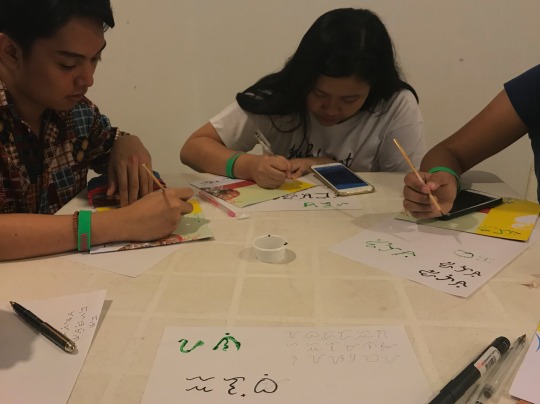
Our first activity was centered on the recently approved national writing system of the Philippines: Baybayin. As it was entitled “Baybayin Henna Tattoo,” my expectation was simply that of a tattoo session, and nothing more. It turned out that there will be a brief lesson about Baybayin, as well—something I don’t look forward to, since I already studied Baybayin way back. I thought our first activity would be a bore. Luckily, our speaker was captivating. Other than the pens and papers, she used her body to dance to us each Baybayin character—yes, she incorporated the characters into a dance. It was a completely different approach from what I normally encounter of Baybayin.
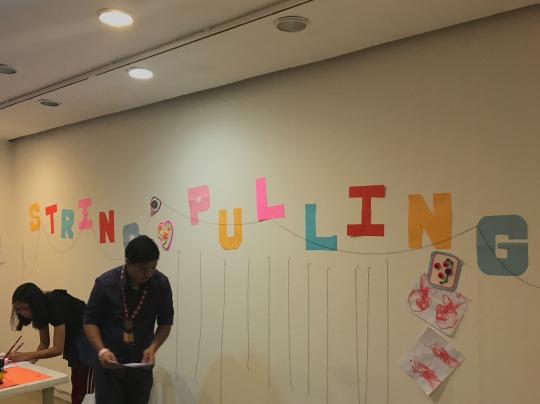
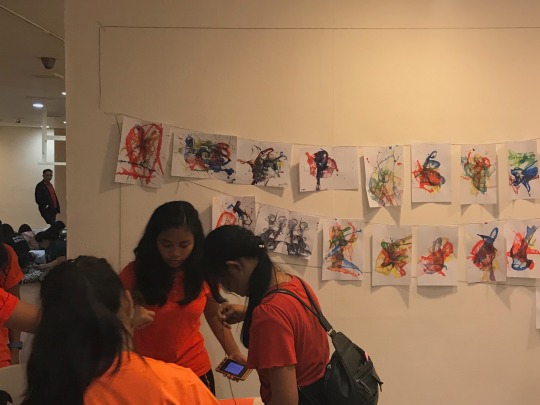

I liked this activity a lot. We were so clueless, and so excited, back then. (Oh, but aren’t we all are?) How are we supposed to do art by pulling a string?
At first, it was a mess. The conductors of the workshop finally told us their little secret, and there we are, able to make anything but art. We got the hang of it eventually. What I loved about the practice was the element of surprise; I chose the colors, I positioned the string, I pulled the string, and yet, when I uncover the paper, what I see is beyond my expectations. I don’t know if it’s just my lack of imagination, though. Lol
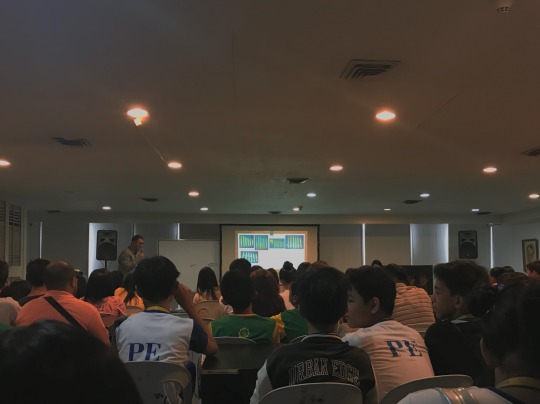
Killing time before our next planned activity, we crashed into a room packed with elementary students. It was a symposium on Ethnic Instruments in the Philippines. I remember a randomly-picked student was asked to play an ethnic instrument, in front, with the supervision of the conductor. To our surprise, he played so well for a first-timer. He didn’t sound like a beginner at all.
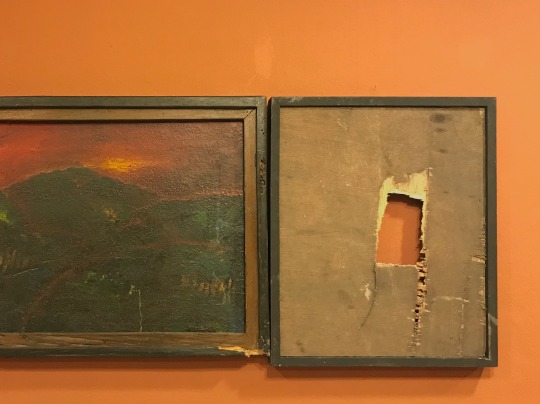

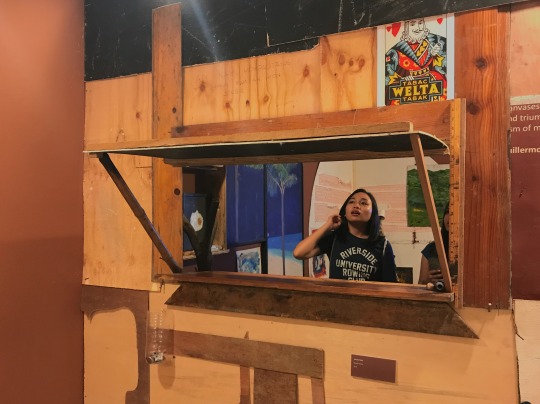
These are from a piece called “Walking Still” by Rene Aquitania. My general feel of this exhibit is that of childhood, and going home.
Also, interesting medium, right?
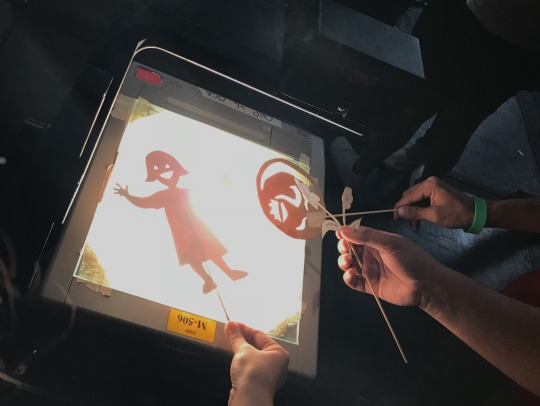

Karilyo Shadowlab. We were so nervous, at first; we thought we are going to do some kind of acting workshop. Lollll. Actually, it was a play of shadows—just like what we do as kids when electricity’s out, and a small candle is the house’s only source of light.
Isn’t it fascinating how something so mundane in your life is a passion to somebody else’s? And as they talk to you about it, you suddenly begin to see how special that “mundane” thing is.

I’m always, always fascinated with old photos portraying life as it is.
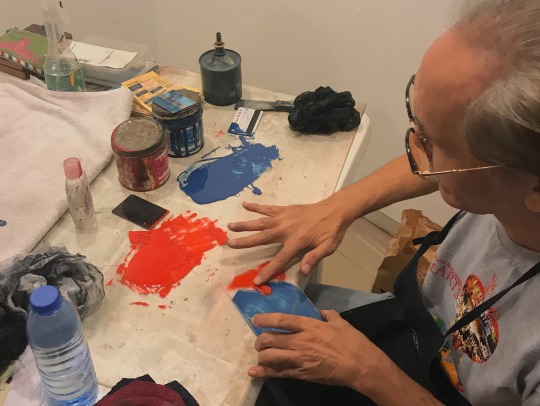
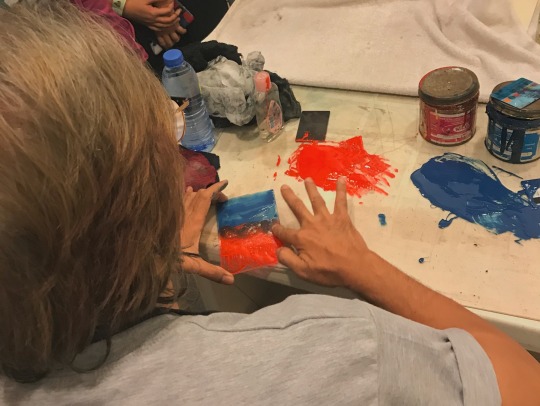

This was my most favorite activity of all—A printmaking workshop. Relief, Intaglio, and Monotype were the three types of print-making that were introduced to us that day.
Relief printing works like stamping. The non-receding surfaces of the plate are also the surfaces that will be printed on the paper. Intaglio is the opposite. Recessed surfaces of the plate receive the ink and will, then, be printed to the paper. Unlike the aforementioned methods, Monotype printing applies the ink to the surface of the plate before making the design. Afterward, the plate will be pressed to the paper like usual.

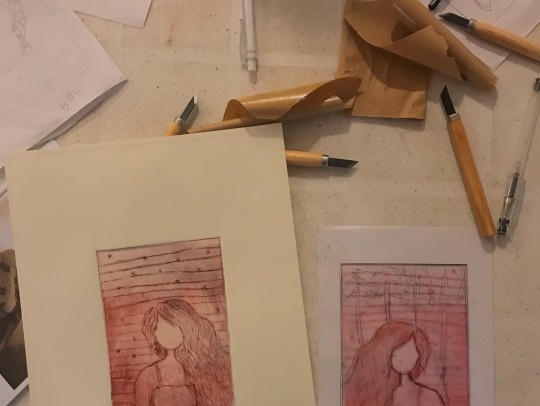
A hands-on activity followed, and we have to choose one; we chose Intaglio. For Intaglio, a printing plate and a carving tool were provided to the participants; these will serve as the paper and pencil respectively. The deeper the carve in the plate, the stronger the color, and vice versa. After finishing out the designs, the teacher covered each of our plates with ink, and wiped the excess. Finally, for the final act, the plate was compressed on damp paper using a heavy roller. The print was successfully transferred, and we let them dry.
In this very technologically-advanced generation, processes as intricate as these are probably considered too time-consuming.
You can do it with one click anyway.
But I swear, experiencing the complexity of it all, process by process, step by step, flaws included, was worth the time. It makes the art so much easier to appreciate.
That was our final activity for the day.
Or so I thought.
At 4 pm, after attending Pasinaya, we went to Intramuros—Manila’s walled city. It was my first time, and it feels surreal. We were able to visit a lot of museums because, to our luck, it was a day of free access to the museums of Intramuros.

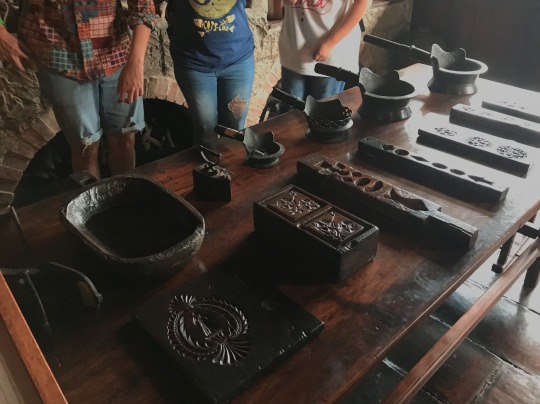
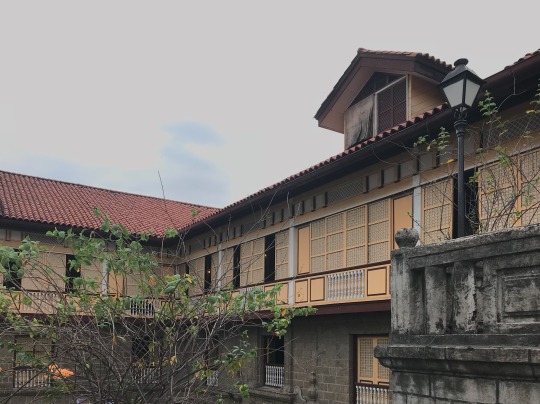
Casa Manila Museum

Jesuit Mission House. Freshly-painted walls that need second coating, dirty glass windows, and floors, and artwork nameplates with no matching artworks. Not at its best that day, but that was how it looked the first time that I saw the Jesuit Mission House. It was a newly-built museum, but since it’s free-access-to-all-museums-in-Intramuros day, visitors were allowed to take a peek. Despite its not being ready for the public, it instantly became my favorite museum. The pieces inside were thought-provoking, sentimental, and haunting.
I was low on battery, so I only have a few photos of the museum. This is a photo of one of the most powerful pieces that I’ve ever seen—a collection of helmets from soldiers. It is such a small and simple piece, yet it already tells so much.
See, all of them were worn out, some even had bullet holes, and some had their signatures and their brief declarations of faith. I wonder what happened to their owners. This is just one of the beautiful pieces inside the Mission House. I won’t talk much. See for yourself.
Morning of February 3rd, I checked my phone half asleep, on the verge of canceling my plans for the day (yet again)—so glad I didn’t. It turned out February 3, 2018 was going to be a nice day.
Side note: This is a very late post. I’m trying to improve my photography nowadays, and I just realized I don’t like--more of, hate--most of my shots here (but I’ll keep them anyway ‘cause I need visuals for this post)
--‘Till next time!
0 notes